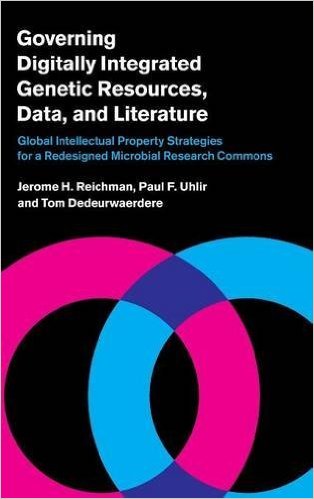Governing Digitally Integrated Genetic Resources, Data and Literature: Global Intellectual Property Strategies for a Redesigned Microbial Research Commons
 Welcome to the home page for the book, Governing Digitally Integrated Genetic Resources, Data, and Literature: Global Intellectual Property Strategies for a Redesigned Microbial Research Commons (Cambridge U. Press, 2016). It was written by Jerome H. Reichman, Bunyan S. Womble Professor of Law, Duke Law School; Paul F. Uhlir, formerly Director of the Board on Research Data and Information at the National Academy of Sciences in Washington, D.C.; and Tom Dedeurwaerdere, Director of the Biodiversity Governance Unit and Professor of Philosophy of Science at the Université Catholique de Louvain, Belgium. The book proposes solutions to one of the most pressing challenges facing research on genetic resources worldwide—from microbial specimens to the human microbiome. It is the culmination of a multi-year grant # P50 HG003391 from the U.S. National Institutes of Health (NIH). Links with more detailed information are included at the end of this message.
Welcome to the home page for the book, Governing Digitally Integrated Genetic Resources, Data, and Literature: Global Intellectual Property Strategies for a Redesigned Microbial Research Commons (Cambridge U. Press, 2016). It was written by Jerome H. Reichman, Bunyan S. Womble Professor of Law, Duke Law School; Paul F. Uhlir, formerly Director of the Board on Research Data and Information at the National Academy of Sciences in Washington, D.C.; and Tom Dedeurwaerdere, Director of the Biodiversity Governance Unit and Professor of Philosophy of Science at the Université Catholique de Louvain, Belgium. The book proposes solutions to one of the most pressing challenges facing research on genetic resources worldwide—from microbial specimens to the human microbiome. It is the culmination of a multi-year grant # P50 HG003391 from the U.S. National Institutes of Health (NIH). Links with more detailed information are included at the end of this message.
The volume offers a blueprint for how developed and developing countries can avoid legal battles over genetic resources that could constrain innovations in the agriculture, biomedicine, environmental management, and microbiology fields. Using the International Treaty on Plant Genetic Resources for Food and Agriculture (ITPGRFA) as a model, it explains how the Convention on Biological Diversity (CBD, 1992) and its Nagoya Protocol (2010)—which currently provide conflicting rules about how countries should resolve disputes about the passage of genetic resources across borders—can be harnessed to create clear Access and Benefit Sharing arrangements for both users and providers at the multilateral level.
Specifically, the book discusses how the Nagoya Protocol confronts microbiology and the life sciences with both a challenge and an opportunity. It details how to reorganize the existing microbial research commons so as to maximize these opportunities and to minimize constraints under international law.
To this end, the Nagoya Protocol expressly validates a multilateral approach that facilitates access to genetic resources for research purposes, as already occurs under the ITPGRFA. At the same time, however, the Protocol casts doubt on the legality of microbial culture collections, such as those affiliated with the World Federation of Culture Collections (WFCC), that continue to operate only as trusted intermediaries under their respective domestic laws. Moreover, exports of industrial products, including those from the United States, that are based on noncompliant genetic resources will become subject to seizure as contraband goods in 192 member countries of the CBD.
The book is divided into the following four parts.
- International Regulation of Genetic Resources and the Assault on Scientific Research
- Preserving the Public Research Functions of Microbial Genetic Resources After the Nagoya Protocol
- A Digitally Integrated Infrastructure for Microbial Data and Information
- Governing Public Knowledge Assets Within a Redesigned Microbial Research Commons
For comprehensive information about this volume, see the detailed Table of Contents and selected excerpts from the first and final chapters of the book.
More information is available from the publisher’s website and from Amazon.com.
Here is a copyrighted penultimate version of the entire volume [46 MB PDF].
If we can provide any more relevant information, please contact us by email directly at:
Jerome H. Reichman (reichman@law.duke.edu);
Paul F. Uhlir (pfuhlir@gmail.com); and
Tom Dedeurwaerdere (tom.dedeurwaerdere@uclouvain.be).
